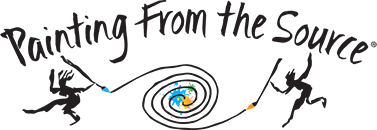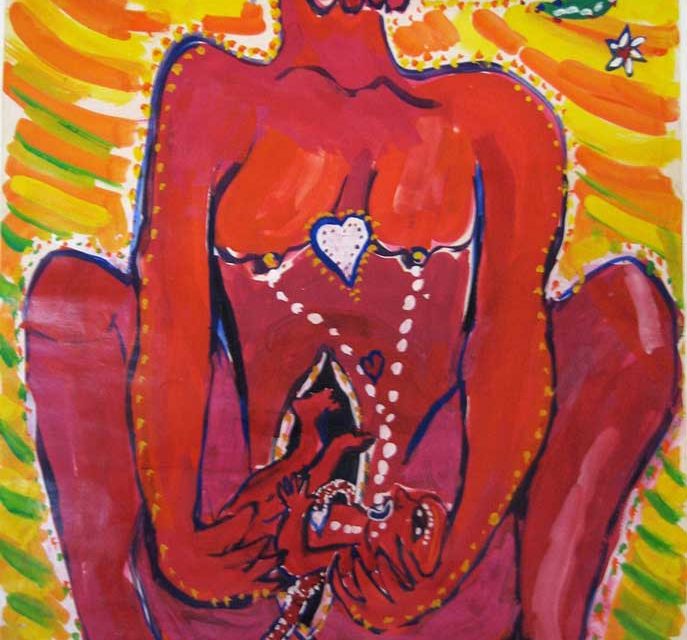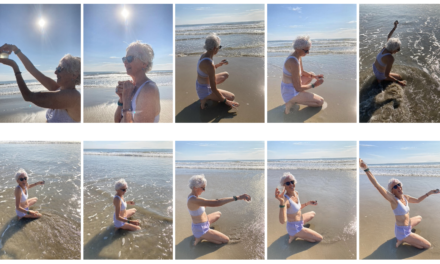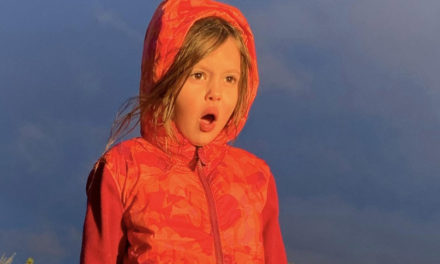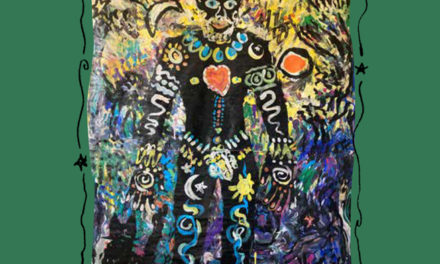
Let me tell you how I recovered the rapturous absorption in creativity that I’d known only in the play and painting of my early childhood. I was one of those children rescued by imagination and natural creativity from a dysfunctional and unaware family. I also suffered from dyslexia and the then-pervasive societal message, reinforced within my family, that females were second-class citizens. In school, the rest of my class did their lessons, while I sat in the back of the room drawing. My classmates’ appreciation of my drawings was my only source of pride and pleasure. When I wasn’t making art, I felt very alone, helpless, and frightened. Like the ugly duckling in the children’s fable, I was always waiting for my real family to claim me and take me home. Sound familiar?
My paintings—my productions—were fussed over and coveted by my parents, whose own creativity was repressed and who offered opinions on what my paintings should look like. A painting I made at age eleven was shown in a children’s exhibit at the Museum of Modern Art—a hard act to follow. I was sent to art school, and then to a high school for the arts, where whatever excitement and pleasure I still enjoyed in painting was steadily leached away by formal training, pressures to conform, and regular critiques. The confidence and resilience needed to use formal training to enhance my inner visions was lacking, as is true for so many women in the visual arts.
Education took me down many paths, but they all led to rigid art-world standards. As I grew up and continued working along the lines deemed “acceptable” within the conventional art world, I drifted completely away from the exhilaration and deep satisfaction I’d experienced from art as a child. The more acceptable I became, the more I secretly yearned for that early bliss, when nothing separated me from the paintings that unrolled beneath my brush as imagery and color rushed out unimpeded.
I grew up convinced that my worth as a person depended upon the “great” paintings I must produce. At the same time, I was cut off from my authentic spiritual flow. I achieved superficial success in art school, college, and graduate school, from sales, shows, teaching art to children and adults, and from studying art therapy. But I rarely reconnected with that unfettered creativity of my early childhood. I spend most of my life caught up in the conflict of yearning for, yet fearing, that profound connection. I displaced my powerful inner need with an addictive and futile search for Prince Charming, a culturally approved diversion from my real quest, which was to recover my authentic self and the euphoric sense of wholeness that comes from genuine creativity.
Inevitably, in the midst of a life that appeared to be blessed by personal and professional success, the crisis peaked. I was trapped in a lie and could no longer live without the transforming truth of my true creativity. Then I stumbled serendipitously, as humans in crisis often do, into an entirely new way of painting—freer by far than the painting technique of a trained adult artist, yet in its teachings and healing powers, much more than the painting play of a child.
Many years ago, after trying many programs to reawaken my creativity, I arrived at a well-known growth center for a five-day workshop in painting naturally. I did not make that workshop easy for those good teachers or myself. With the clarity of hindsight, I now realize that my resistance was comically classic.
My first two and half days at the workshop were murder, as I painted myself into genuine misery. At first, being set loose in a room with all those delicious colors and large sheets of blank paper was thrilling. “A piece of cake for me! I’m right in my element! I’ll show them!” The first hour was especially fun, playing with paint again, my reliably facile painter’s tough was on display. But very soon, “the great artist” was shot down. Under my own hands, my familiar lush abstract landscapes turned to mud. I looked around at the old-timers in the workshop and cringed. Their paintings looked crude, unashamedly raw, even jarring. “This isn’t art!” I though. “I don’t know what it is!”
One woman unrolled a large painting in progress that had expanded onto many sheets of paper. She continued working on the tiny details, hundreds of tears falling from the eyes of a roughly rendered mother with a child on her lap. The painting hung in my view, offending me and making me uneasy. I would never paint such a scene. Later I realized this painting touched a painful sense memory of unbearable isolation and helplessness sitting on the lap of my distant mother. Also I was annoyed at the leader’s insistence that we finish one painting completely before going on to the next. I ignored her directions. I used many sheets of paper and began many paintings. Yet I hated everything I did. This free spirit, this accepting therapist I thought I had become, resented each and every person and painting in the place.
The headache that had begun on the first day intensified on the second. I couldn’t paint anything that mattered. Even worse was the nagging fear that I hadn’t expressed anything because there was nothing that really mattered inside me. Again, hindsight sheds some light on my struggle.
I was paralyzed by my lifelong investment in my self-image as an artist and my fantasies about greatness. Better to keep believing that my creative magic was locked inside somewhere than to paint from my true self—whatever that was—and discover that I had no magic after all. Even if I discovered that my magic was real, owning it would mean I’d have to give up that familiar feeling of longing. I was used to that feeling. It was a no-win situation.
I took another sheet of paper and painted a fish. It was okay. Then, on yet another sheet, I painted an old favorite: a scallop shell resting on the sand near the surf . . . hmmmm, “a gift from the sea.” Blue-green, salty waves washed over the sand and onto the shell, reminding me of when I had painted the mysteries of the sea twenty years earlier in graduate school. This water filled with sea life stirred something in me. Suddenly, just when I thought I was finished, I saw traces of a woman’s face in the scallop shell. What to do? Struggle. Not the least of my blocks was snobbism, a false sense of superiority. I felt trapped in dissonance. What would my art professors say about this? All those years, money, and effort studying every aspect of art: anatomy, life drawing, aesthetics, color design theory and technique, ancient to modern art history. How could I throw all that away and paint as if those years of study hadn’t happened? That would be a waste, completely illogical and self-defeating.
My heart beating faster, I painted the woman’s face in the scallop shell anyway. Her shoulders, outstretched arms, and breasts appeared in the sea. Her nipples were pink starfish. Something long dormant began to awaken in me, long-forgotten childhood paintings of mermaids. To the objective, art-trained eye, this was a mediocre painting, nothing to turn anyone’s head. As I painted the finishing stroke, I allowed the disapproval I’d internalized from my family and teachers to wash over me for a few moments. Then that disapproval began to ebb away, and the image of what I must paint welled up in its place. This woman-in-the-sea painting was the bridge to my next one, my breakthrough painting to the source.
I dipped my brush into bright magenta paint and boldly filled a new sheet of paper with the large, squatting figure of a birthing woman. With no concern for the correctness of her anatomy, I showed her ample hands holding a newborn girl just emerged from her oversized vagina. As the African mask-like face of the mother gazed down at the infant with the bonding force of passionate, unconditional love, milky drops fell from her breasts into the infant’s open mouth. Holding back nothing, I painted a heart in the chests of each, mother and child, and a dazzling nimbus of energy radiating from their bodies. Then something prompted me to paint in opposite corners a green crescent moon and a red sun enclosed in a red circle—my newfound signature. Finally, I painted an umbilical cord attached to a heart-shaped placenta.
I was in ecstasy. Nothing else mattered but this painting. My entire being knew I was home. I felt the sweetness of reconnecting with a soulmate after many lifetimes of separation. I doubted if there was anything else left in me to paint. I didn’t realize it then, but I know now that I had painted my version of God/Goddess/Creation—the mother I had longed for to adore my newborn self, as well as the mother I had become in birthing my own creativity. In doing so, I had empowered myself greatly. “I could die right now and be satisfied,” I signed contentedly. Yet at the very instant of this painting’s completion, I became fascinated by the prospect of yet another painting. I knew what it would be and how I would paint it.
Within a very short time, I began to see that this new way of perceiving and painting did more than restore depth and spontaneity to my work: It was a force for positive life change in countless ways. For the first time I understood the meaning of the word transformation. Each painting offered me the opportunity to confront and resolve an inner conflict, fear, or other deep issue, including, to my surprise, health problems. As these conflicts, fears, and issues came to life as images in my paintings, I was able to recognize and resolve them, and that healing touched and enhanced every aspect of my life. It seemed as if all my senses heightened and became more sensitive, as though I now perceived the world around me through a multitude of channels. I became more open, bolder, and self-confident. My anxiety attacks disappeared, along with the aches and pains of arthritis at the completion of a particularly intense painting. Tapping into my creative source made me feel more worthwhile, so I began eating better and exercising more. My “voltage” soared. I developed new personal style and flair. I felt more attractive and sensual, and I began to view others in a more generous and compassionate light. Life’s obstacles, great or small, no longer intimidated and paralyzed me because I began to trust myself and the universe. I now knew that whatever fate presented to me, I would make the most of it.
Thus began the series of openings and self-discoveries through painting that has led me to share my experiences with you. Facing that blank sheet of paper and moving my paintbrush across it without plans or restrictions allowed a lifetime’s worth of disbeliefs and blocks concerning painting—and life—to finally surface and express themselves. In order to be really real, to feel truly alive, I had to confront those issues about being unprofessional, ignorant, empty, childish, mediocre, worthless, and appearing that way to everyone else. I had to acknowledge and release my spite, that is, I had to let go of wanting to stay entrenched in my unhappiness so I wouldn’t have to let my family—and even God—off the hook for abandoning me. I had to stop holding them hostage for my unhappiness. I had to let go of my fears of being competitive and envious, as well as my fears of being the target of someone else’s envy. I had to let go of the fear that something bad would happen to me or to my family, particularly my mother, if I were to live fully, sensuously, and be truly creative. I had to release the fear of being alone, isolated, crazy, and excessive. And I even had to say good-bye to the fear of being connected and whole. Images of the many illusions and beliefs that had sustained and bolstered, while simultaneously suffocating me, appeared in my paintings in order to say that they had been living within me and now wished to go. In their place came new engagement in life, a greater sense of fun, and the certainty that I was fine and complete all on my own, just as I am, without anyone else’s approval or praise. I can now see how yesterday’s wounds have prepared me for today’s triumphs and teachings.
Love and bless, ag
